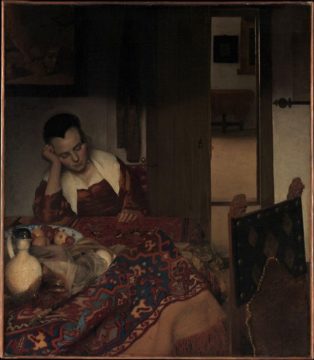Morgan Meis at The Easel:
 Sometime probably in 1656 or 1657, Johannes Vermeer painted a painting that we now know as A Maid Asleep. I reference this painting because it hangs at the Metropolitan Museum in New York City. I’ve looked at it many times. I have a relationship with this painting. I’ve loved it for years and for that same amount of time I’ve been trying to figure out why.
Sometime probably in 1656 or 1657, Johannes Vermeer painted a painting that we now know as A Maid Asleep. I reference this painting because it hangs at the Metropolitan Museum in New York City. I’ve looked at it many times. I have a relationship with this painting. I’ve loved it for years and for that same amount of time I’ve been trying to figure out why.
There is, as many people have pointed out, a sense of quiet and mystery to A Maid Asleep that’s quite visceral. You just feel it. The overall mood of the painting is established, obviously, by the image of the half-sleeping maid resting her head on her hand. But the door opening into the room just behind, the spare room that beckons our gaze, this room is probably more important than the maid in creating the dreamily intriguing mood of this painting. The crucial factor here being a sense of revelation. The half-opened door reveals another room. The painting asks us to probe deeper, to look further. At the same time, it also suggests that there is nothing further to see. Because when we look into that back room, it’s just another room, another room that’s actually less interesting than the room we’re already in. So, this is a painting that structures itself like a revelation and then, simultaneously, pushes our probing minds and eyes back out onto the surface again. It is a painting that short-circuits itself, leaving the viewer fascinated and frustrated all at once.
That’s not an easy thing to do in a painting.
More here.
